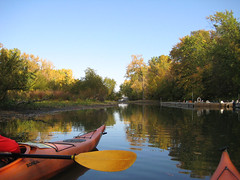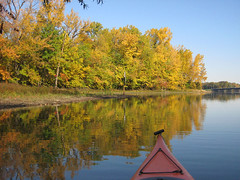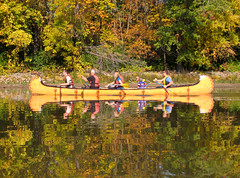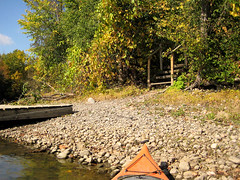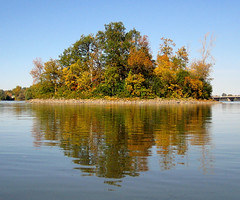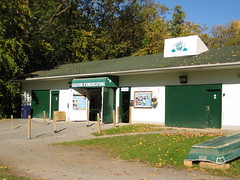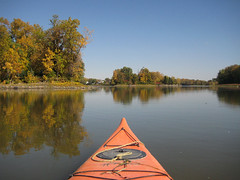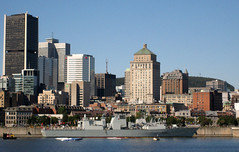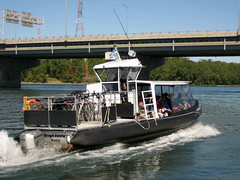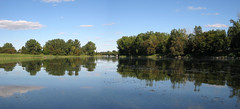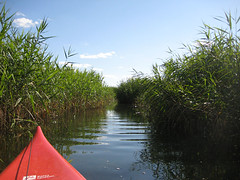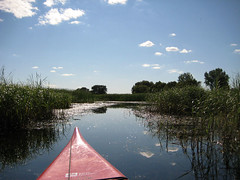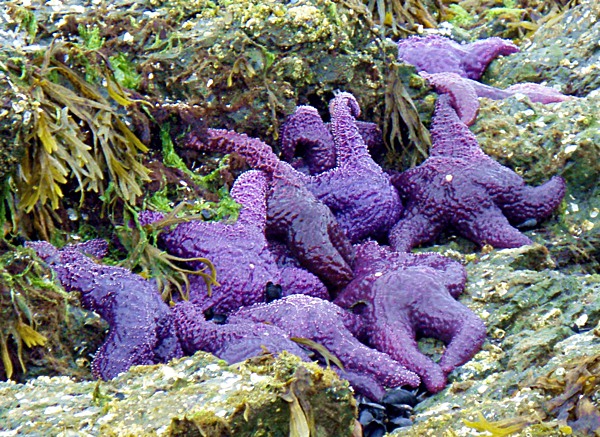Although Parc nationale des Îles-de-Boucherville has year-round auto-access (by tunnel and autoroute, no less), getting there by public transit is more challenging. Last year I missed the 3-or-so month season of the navettes (ferries) to and from the park. This year I was determined to make it over at least once. A couple of weeks ago, I’d looked at the temperature and wilted. This weekend, newly hardened by our “heat dome”, I didn’t look; I made my plans, packed my bag, and set out.
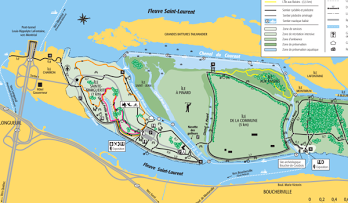
The navette from the Montreal side leaves from Parc Bellerive on the east island. With Sunday bus service, I figured I was going to miss the first ferry at 10 am, but it was still there when I trotted up to the dock about 5 minutes past. I paid my $8.00, clambered aboard. Brisk zip with a certain bounce along the St Laurence to the dock on Île Charron (that’s the incoming dotted line to the upper left of the island-mass on the map), past a formidable looking radar monitoring station and into a rectangular bay of calm stale water, with a slight whiff of anaerobic mud.
This did not put me into the Parc proper; rather disconcertingly, I climbed up the short path from the dock and I found myself plunk beside a roaring highway, rising up from underground. However, a dozen or so yards away, a cinder track turned off to the left and I left it all behind. All the other ferry passengers had bicycles, so I shortly found myself alone, tramping across Ile Charron; the map said 3.5 km to the Centre de Locations, about half way down the channel between Île Sainte-Marguerite and Île Saint-Jean. I’ll compress the land-bits, save that the temperature was already heading for the high-whatever and I was feeling the lack of shade because of the well-cleared zone around the path, I gave one of the local lifeforms a flying fright, catching only a glimpse of reddish flank and a great thrashing wave retreating through the tall grasses (I was put in mind of Sheri Tepper’s Grass, though obviously it was not a foxen). I crossed over a road-access, and walked by two parking lots, something that seemed mildly surprising and ever so slightly indecent. At the entrance I paused to puzzle over whether or not I needed to put a bit of my ticket in the self-pay envelope to establish I had paid the entrance fee – which I knew was included in the ferry fare – but decided I probably needed it with me. As it turned out, I was right.
Once in sight of the rental shack, I had a gazpacho-break in the broad picnic area, and then went and snagged myself a boat ($35 for 3 hours). I did not (remiss of me) take a note of the name, save that it had 6 letters, and was Inuit. The kayak was bright red, hard glossy plastic, with a rudder, probably a 14′. Very comfortable seat with good back support. Foot-pedals on a strap, sparing me the usual contortions adjusting them as I floated offshore, having cleared the busy beach. I need to bring my sandals next time – paddling barefoot is too hard on the heels, but walking 7 km in those sandals is too hard on the feet. On the deck, waving like a tongue, was a laminated Parc map about 9 inches long, secured at one end. The man at the booth assured me the circuit on the map was doable in 3 hours, and that I should start by heading south.
However, in not looking at the temperature, I also missed taking note of the wind. I have no photos of the initial paddle down Chenal Grande Riviere. The paddle I had was fixed, not feathered, and felt shorter than I was used to, and I needed to hold my course between the reeds and various pleasure-boats, against the wind. Later I read it was 15 kph N with gusts up to 30 kph, per environment Canada, but even by Montréal’s idiosyncratic definition of directions, that wasn’t a north wind. I hugged the reeds along the right shore until the debouchment into the Fleuve Saint-Laurent, checked for oncomings, and slogged across the choppy water to start along the south shore of Île de la Commune. There are no photos of this section, either, because I still had the headwind, and in addition, had wakes kicked up by the assorted pleasures boats’ more energetic cousins, all the way to the turn-in to Chenal la Passe. I also had company, a couple in a red rented double, a family of three in a canoe who could not all paddle in the direction at the same time, and a couple probably in their own boats, bold enough to swing out clear of the shallows and the worst of the chop. I think they all had more ambitious plans than I, because when I turned into the Chenal la Passe, none of them followed me.
Something else did. I was admiring the wooden bridge which carries the foot/bike path over the Chenal, when I heard a clatter of outboard behind me. It refused to be willed away, and further asserted itself with a puff of diesel flatulence, before parking in the middle of the channel. I can haz torpedoz, I darkly muttered, and scooted past before the fishhooks came out. I met the breeze again coming down, making that five points of the compass it covered, though it was much lessened. And when I got to the top of the Chenal and turned west, putting the wind more or less at my back, and hitched myself around (flexibility exercises! must do!) and discovered that although I had not checked that the rudder was unhooked, it was unhooked, and I could flip it down – suddenly my Sunday workout became a Sunday cruise. On both sides I had reeds and what seemed a thin line of low trees. Straight ahead, I could just see civilization in the form of a pylon. The omnipresent city hum was almost inaudible. On the way up the Chenal, I caught sight of a kingfisher, glimpse of blue and pale, dashing past, a little mustard-coloured finch-like bird, dotting from leaf to leaf, the ubiquitous red-winged blackbird, and the hovering black-winged seagulls. Though the map suggested one hugged the shore, I needed to steer wide around mats of frothy spew of yellow-green weed (the only way to describe it). In amongst the reeds, I could see water-lilies. There was the occasional white one, open, and faintly luminous, with the peppering of tiny insects in the base of the cup, but more of the closed fist-like yellow ones, pushing above the waters on their stems.
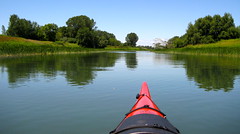

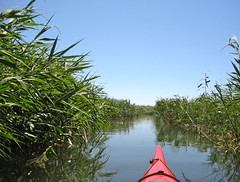
Then the reeds closed in. Shiny, green, about 3 feet high, with the wind hissing through in a mean-girls whispering; they narrowed the passage down to a single navigable channel. The movie clip captures the motion and something of the sound, though coarsely through the little microphone. I think that sudden flight of birds is of red-winged blackbirds, and the creaking is the sound of my plying the rudder, steering. Just after I had put the camera down, two double kayaks, as red as mine, appeared before me, and we were occupied in trying not to run into each other as we maneuvered past. I heard the occasional grunt and mutter of a heron, but only saw one, when it launched to my left and floated parallel to my course for several impossibly slow wingbeats, before it settled out of sight again. It was one of those long suspended moments that are still far too short to go for a camera. Something behind me started shrieking and crying in piteous alarm, though I have no idea whether I was the provocation, or what it was. Once out of the reeds, I paused to drink yoghurt turned liquid the warmth and finish my Jamaican pastry. Then I carried on down the channel past assorted route markers and the occasional cryptic sign, thinking about the unmistakable high summer blue-green of the foliage, just before it starts to look tired.
Chenal la Passe turned into Chenal Grande Riviere, and I was very shortly back among the pleasure-boats, with the bronzed and bodacious disporting themselves. A large shaggy golden retriever on the deck of one gave the peasant in her kayak the stern retainer’s eye. The circuit had taken me 2:15 hours, and though I was tempted to turn back amongst the reeds, I was tired and my eyes were dry and scratchy. So I beached, off-loaded, and, the attendants being occupied, discovered that using the trick of lifting the boat onto my thighs before shouldering it, I could heft a plastic kayak pushing 50 lb. Though I would not have wanted to load it onto a roof-rack solo, and maneuvering with only a 90 degree field of view and 7 feet of kayak sweeping fore and aft is not something I like to do with as many people around – so in future I will wait. But I returned it to its rack without injury to myself or anyone else, and my return was timely, because the line at the rental shed was getting ever longer and the supply of visible boats, dwindling.
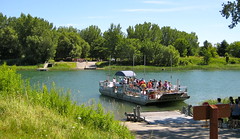
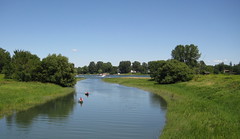
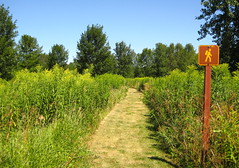
Back on land, I’d the choice of walking back to Île Charron and taking the navette back to Bellerive, or continuing on to the other dock, walking along the shore I’d just paddled beside, crossing over Chenal la Passe and getting a shuttle over to Boucherville itself. The distance, walking, was about the same, and I wanted to scout out the second route, which seemed to me the most feasible way of bringing the Dragonfly over. So I got to see a quite different aspect of the island, because although from the water it looked wildish, inland, it had been cleared and put to the plough and looked not unlike parts of central Saanich. I crossed the Chenal Grande Riviere on the cable-ferry, and the Chenal la Passe on the bridge I had admired. On foot, ducking down the grassed footpath which ran parallel to the track, I was in a minority, most everyone else being on bicycles. This time I knew I’d miss the ferry, which according to the schedule left on the half hour, but I was pleasantly surprised to discover that, whatever the schedule said, the ferry was only pausing to off- and on-load passengers. My ticket turned out to be a return, and I hopped aboard, bound for Boucherville. The young man at the helm took off with brio, including some wide swishing turns that kicked up white spray and were – fun. Yes, indeed, maybe I can understand the appeal of going really fast over the water. (But I didn’t squeal.) My luck held at the other side, because after a short, pleasant wait, the hourly bus (81) hove into view, and I had even had the foresight not to spend all my change. The one downside of the southern route is the Boucherville bus is a separate fare from the Montreal one; on the other hand the ferry is cheaper. And so to the Metro station and back into town.
Here’s the first selection of photos; there may be more.












